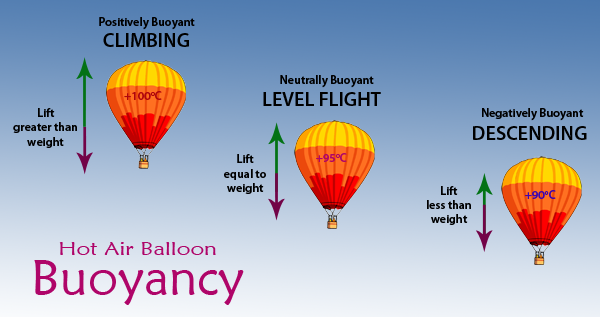It states that a body immersed in a fluid is buoyed up by a force equal to the weight of the displaced fluid. It applies to both floating and submerged bodies and to all fluids, i.e., liquids and gases.
It is discovered by ancient Greek mathematician and inventor Archimedes.

In determining whether a given body will float in a given fluid:
- If the body is less dense than the fluid, it will float or, in the case of a balloon, it will rise.
- If the body is denser than the fluid, it will sink.
- If the body is two thirds as dense as the fluid, then two thirds of its volume will be submerged displacing in the process a volume of fluid whose weight is equal to the entire weight of the body.

BUOYANCY
The difference between the upward and downward forces acting on the bottom and the top of the cube, respectively,is called buoyancy.

TYPES OF BUOYANCY
- POSITIVE BUOYANCY
- NEGATIVE BUOYANCY
- NEUTRAL BUOYANCY
POSITIVE BUOYANCY
It occurs when an object is lighter than the fluid it displaces.
The object will float because the buoyant force is greater than the object's weight.
Example ->
A swimmer experiences a great amount of buoyant force. Israel's Dead
Sea is famous for attracting floating tourists. Saltwater is more dense
than fresh water and provides more buoyant force. Buoyant and net forces
are not the same. An object's volume and density determine its
buoyancy.
NEGATIVE BUOYANCY
Negative buoyancy occurs when an object is denser than the fluid it displaces.
The object will sink because its weight is greater than the buoyant force.
Example -> A
submarine is designed to operate underwater by storing and releasing
water through ballast tanks. If the command is given to descend, the
tanks take in water and increase the vessel's density.
NEUTRAL BUOYANCY
Neutral buoyancy occurs when an object's weight is equal to the fluid it displaces.
Example ->
A scuba diver is trained in techniques to regulate buoyancy underwater.
Swimming horizontally and taking deep, long breaths allow the diver to
propel forward, not upward. Fish control buoyancy through an internal
swim bladder. Similar to a submarine, the bladder is filled with gas as a
means of altering buoyancy.

A Floating Balloon
Buoyancy
determines the ease of a floating balloon. Hydrogen, helium and hot air
are the ideal gases for balloon aviation. Unlike liquids and solids,
gas molecules are spread farther apart. This empty space increases
volume and decreases density. Astronomers use unmanned hot air balloons
to gather clear pictures of the cosmos.


Post a Comment
Post a Comment